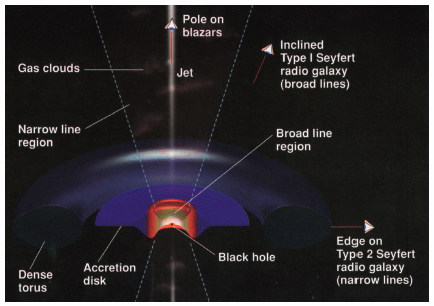Studying AGN
Introductory comments from Varoujan
I have been very interested in Active Galactic Nuclei (AGN) for some time. Here is a brief introduction to the key points.
Basically AGN are galaxies that emit an excess of light from their centers beyond the sum total of light that should be coming from their central stars. It was initially postulated that this was due to a great deal of star formation but over time it was realized that it would be impossible to have that much star formation in such a small volume. The accepted paradigm became where a large amount of gas was flowing into a supermassive black hole at the center of an AGN. As the gas flows in, it forms an accretion disk and the friction of the gas with itself as it spirals in causes the disk to heat up and emit a lot of light, especially in the UV. Then, any dust that surrounds the disk absorbs that light and re-emits it in the infrared.
This link has a bit more background on AGN in general. No need to understand all the details but I think it gives a nice history of these objects. http://nedwww.ipac.caltech.edu/level5/Cambridge/frames.html
AGN key points
1. AGN emit light because inflowing gas from the host galaxy forms an accretion disk around a black hole. The accreting gas heats up and starts emitting light -- just like anything else that is heated emits light. Think incandescent bulb except a lot hotter.
2. The accretion disk emission has a continuum (blackbody) emission which peaks in the UV. There are no emission lines that come from the disk much like there are no emission line that come from the surface of a star.
3. Broad Line Region (BLR): Near the surface of the disk (but NOT a part of the disk) is very fast moving gas being illuminated by the light coming from the disk. The accretion disk light stimulates that nearby, fast moving hydrogen gas to emit various emission lines (Think neon light). These emission lines are Doppler broadened because of the fast motion of the gas.
4. Narrow Line Region (NLR): Far from the disk are hydrogen and other gasses that are also being illuminated by the light from the accretion disk and stimulated to emit various lines (also think neon light). But since these gasses are moving a lot more slowly, they do not Doppler broaden their emission lines as much as the BLR gas.
5. For some AGN you see both the BLR and the NLR and for some you only see the NLR. A Unified Model has been proposed to explain why sometimes the BLR is visible and sometimes it is not. The two categories are Type I where the BLR and NLR are both visible, and Type II where only the NLR is visible.
6. It has been theorized that a torus of gas and dust surrounds the accretion disk and hence blocks some viewing angles from seeing the BLR. Those viewing angles that can see both the NLR and the BLR categorize the AGN as Type I. For those AGN where the BLR is obscured by the torus and only the NLR is visible they are categorized as Type II. In short, if you see the BLR it's a Type I, and if you don't it's a type II.
7. The infrared light form the AGN comes from the dust in the torus. The dust absorbs the optical/UV light coming from the accretion disk and re-emits it in the IR. This is also continuum emission, but it peaks in the IR (think incandescent bulb but a lot cooler).
Also check out this helpful animation at: http://castor.adlerplanetarium.org/viz/agnlab/agn_model.html .
